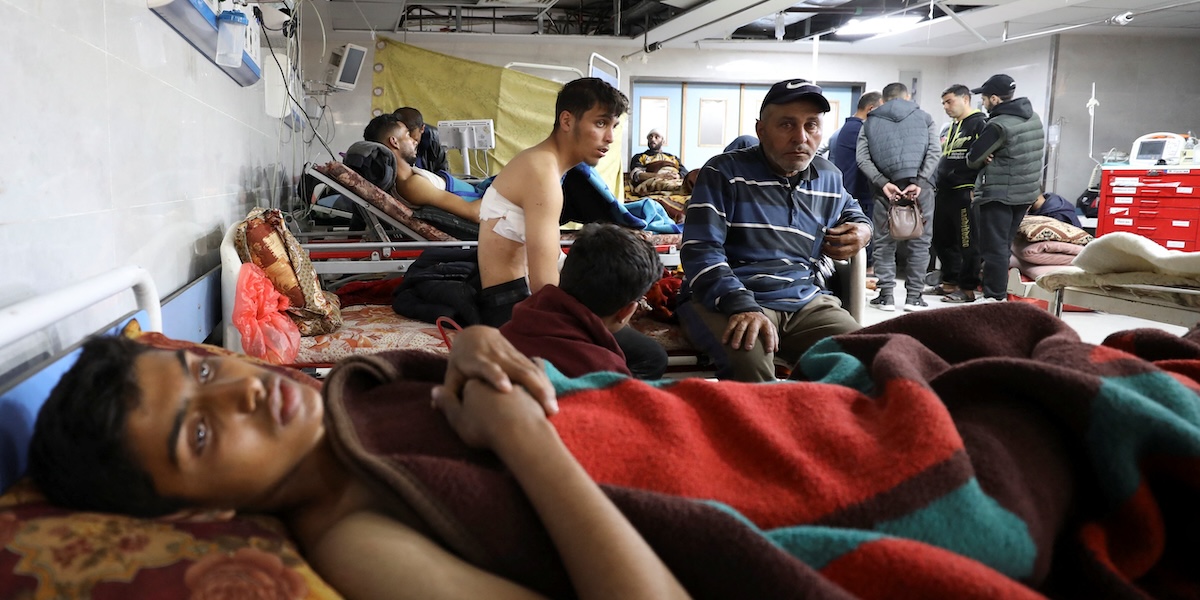Loading player
The dynamics of the massacre of Palestinian civilians which occurred in the early hours of Thursday, while a crowd was gathering to receive food from some humanitarian aid trucks in the city of Gaza, the largest in the Strip, are not yet entirely clear. In fact, everything happened when it was still dark and the images provided by the Israeli army, taken by a drone, do not help to reconstruct the sequence of events precisely.
Since yesterday, however, some testimonies have been collected from people who were present, and which in some ways confirmed the version given by the Gaza Ministry of Health (i.e. Hamas) which had immediately accused the Israeli army of having shot and killed at least 112 Palestinian civilians. The Israeli army had instead claimed that its soldiers had fired shots only in the air and at the legs, and that people had died due to the crowd that had created around the trucks. Meanwhile, the humanitarian situation in the Strip is almost collapsing.
Aerial footage of the operation to bring humanitarian aid into the northern Gaza Strip, showing how the Palestinian crowd attacked the trucks and as a result dozens were killed from overcrowding, crowding and trampling>> pic.twitter.com/a7DqU9kKFB
— Israel Defense Forces (@idfonline) February 29, 2024
The massacre occurred between 3.30am and 4.30am on the night between Wednesday and Thursday (between 2.30am and 3.30am Italian time), when thousands of Palestinian civilians had gathered along a coastal road in the north of the Strip waiting for the aid trucks. Among them was Mohammed Al-Sholi, a 34-year-old taxi driver who had camped a few hours earlier with friends to try to bring home food for his family. In a telephone interview with the New York Times, Al-Sholi he said that “just before the truck arrived, a tank had begun to move towards the gathered people.” It was around 3:30 in the morning local time when, according to him, an Israeli tank “had fired some shots into the air”.
At that point Al-Sholi had started running to hide in a destroyed building: in the meantime, he says he “saw people fall to the ground after being hit” by shots fired by the Israeli army, and others “taking food that they had with them and continue running to save themselves.”
Mohammad Hamoudeh, a photographer, always told the New York Times that when civilians were near the aid trucks to get “food, water and everything they could get”, “the tanks started shooting directly at the people”. “I saw them shoot directly with the machine gun,” she added.
These are stories to be taken with a certain caution, in the absence of confirmation, but similar to those of other witnesses, including a man heard by Al Jazeera, who was in the area around 4:30 p.m. The man, whose name has not been released, he said that as soon as the trucks arrived the Israeli army began “shooting randomly at people, as if it were a trap.” Both he and other witnesses also spoke of an air attack carried out at the same time as the shooting.
According to testimonies collected in recent hours by the international media, the Israeli army fired on Palestinian civilians even as they were fleeing. He would continue to do so both when the first aid trucks arrived and in the following hours, until 7 in the morning. Also according to Al-Sholi, some people were hit and killed by the same trucks in the chaos.
Health authorities in the Hamas-controlled Strip accused the Israeli army of firing into the crowd, killing at least 112 people and wounding more than 700. Israeli army spokesman Daniel Hagari denied that Israeli soldiers had fired. about people waiting for humanitarian aid, claiming instead that they had done so “when the mass had begun to move in a way that put them in danger”. Again according to the Israeli army, the soldiers had only shot in the air and at the legs and most of the Palestinian people died due to the crush, while other people were killed because they were hit by aid trucks.
At least one of these trucks was used to transport the people killed or injured in the massacre to area hospitals.
Eid Sabbah, the head of nursing at a hospital in the north of the Strip, says that 95 percent of the approximately 150 wounded and 12 dead people brought to his hospital had gunshot wounds, particularly in the chest and abdomen. It is a version similar to that given by Jadallah al Shafei, the head of nurses at the al Shifa hospital in Gaza, who told Al Jazeera that “most of the dead and wounded had gunshot wounds and shrapnel in the head and upper body.” Mohammed Salha, the acting director of Al-Awda hospital, also he said that more than 80 percent of the 176 people hospitalized there had gunshot wounds.
– Read also: What is known about the massacre in Gaza
The majority of Palestinian civilians, around 1.4 million, have been refugees for months in the southern part of the Strip; however, many remained in the northern area (where the city of Gaza is located), where Israeli attacks have intensified again for a few weeks.
The humanitarian situation in the Strip is now very serious, also because Israel’s controls on convoys, the shortage of drivers and the risks for personnel transporting the aid, among other things, have caused major delays and interruptions in its distribution. From February 1st to 27th, only 96 aid trucks entered Gaza per day, 30 percent less than those that entered in January: before the start of the war between Israel and Hamas on October 7th, aid trucks entered every day 500. On Friday, the day after the massacre, US President Joe Biden announced that the United States will parachute humanitarian aid into Gaza, to try to help the Palestinian civilian population, as other countries are already doing, including Jordan and France.
